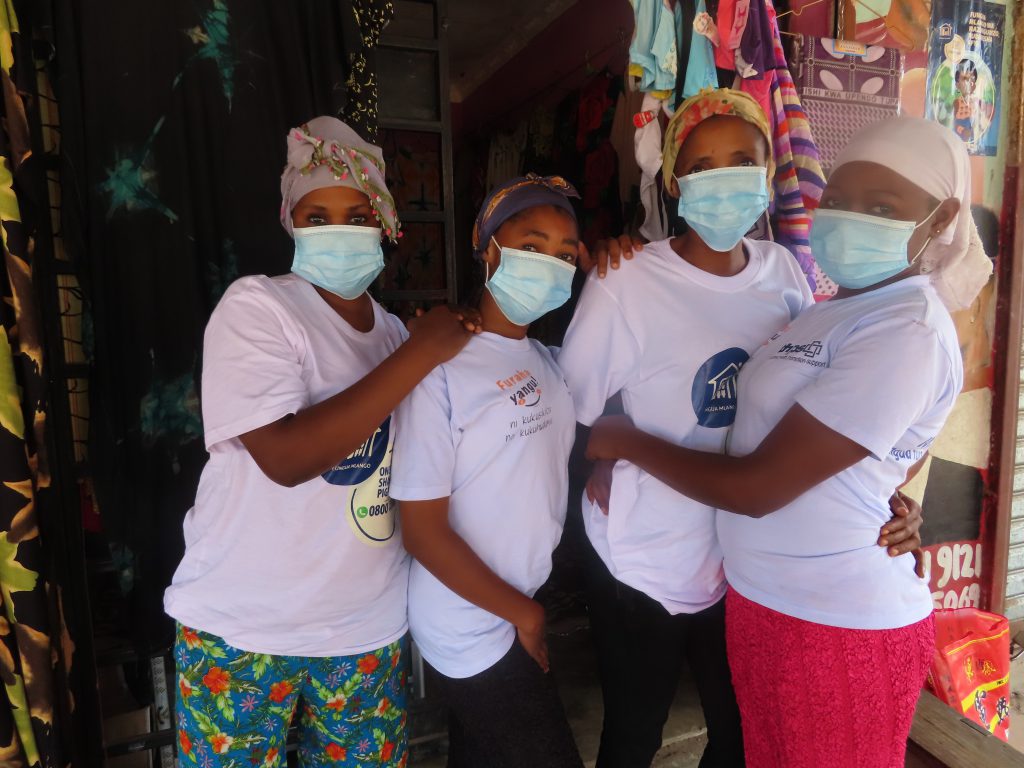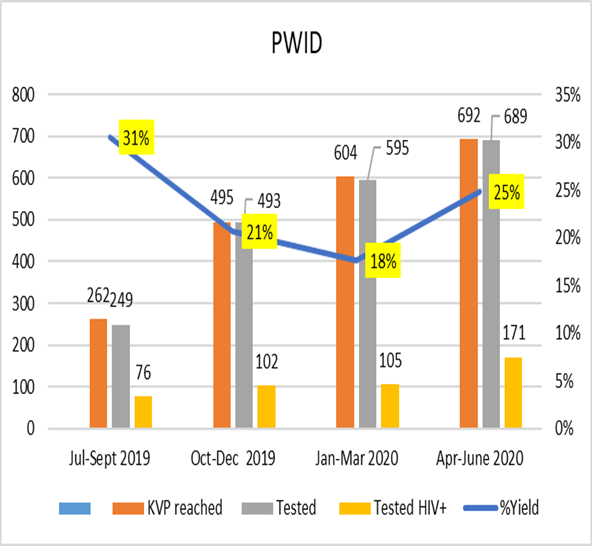The Global Fund Mlango Project

In 2018 THPS received The Global Fund support as a Sub recipient to Amref Health Tanzania to implement comprehensive combination HIV and TB prevention activities for key populations i.e. people who inject drugs (PWID), female sex workers (FSW), men who have sex with men (MSM), and other vulnerable populations i.e. fisher folks, truck drivers, miners, plantation workers in thirteen regions (Arusha, Kilimanjaro, Manyara, Tanga, Dodoma, Morogoro, Mbeya, Mtwara, Pwani, Mara, Simiyu, Shinyanga, and Kigoma) covering 27 districts under the MLANGO project.
‘MLANGO’, a Swahili word for door, carries a broad message of hope for the project’s beneficiaries in opening up access to quality health services. These groups have limited access to health services including HIV prevention, care, and support and yet are at much higher risk of acquisition of HIV and other opportunistic infections. The MLANGO project (April 2018 through December 2020).
THPS uses community-based combination prevention approach that entails biomedical, behavioural and structural interventions implemented in partnership with communities and civil society. Other key stakeholders are MOHCDGEC through National AIDS Control Program (NACP) and National TB and Leprosy Program (NTLP), PO-RALG, Tanzania AIDS Commission (TACAIDS), and Tanzania Drug Control and Enhancement Authority (DCEA). At regional and district levels, THPS works closely with Local Government Authorities, 13 indigenous national umbrella NGOS and 23 community based organisations. Selected key and vulnerable populations (KVPs) trained as peers assist with identification of hot spots, peer to peer counselling, facilitate referral to health facilities after the initial community interventions.
Mlango Project’s Geographical Coverage
Project Goal
Increase coverage of HIV and AIDS services in key population and ensuring that by 2020
- 90% of people living with HIV knows their status
- 90% of all people diagnosed with HIV are enrolled, followed and receive timely and efficacious highly active antiretroviral therapy
- 90% of all people receiving the antiretroviral therapy will attain sustainable viral suppression
- increase TB case detection by 29% through strengthening routine case notifications and addressing vulnerable groups such as elderly, prisoners, miners and diabetics
MLANGO project’s key interventions for Key and Vulnerable Population (KVP)
| Biomedical | Behavioral | Structural |
|---|---|---|
| 1. HIV diagnosis, treatment, care and support (HTS, ART, PMTCT, PEP with emphasis on index testing. | 1. Peer education | 1. Sensitization of political, religious and community leaders to address HIV infection among KVP. |
| 2. Screening and treatment of Sexually Transmitted Infections (STI). | 2. Targeted information, education, and communication. | 2. Financial literacy. |
| 3. Screening, prevention and management of TB, hepatitis, mental health and other Non-Communicable diseases (NCDs). | 3. Condom promotion and provision. | 3. Saving. |
| 4. Sexual and reproductive health services including cervical cancer, Voluntary Male Medical Circumcision (VMMC). | 4. Personal development and family reintegration. | 4. Loaning. |
| 5. Harm reduction | 5. Peer support groups. | 5. Income generating activities. |
| 6. Gender Based Violence (GBV) Screening and medical care for GBV survivors | 6. Counseling and other forms of psychosocial support. | 6. Cash transfer. |
| 7. Stigma reduction | 7. Vocational training. | |
| 8. Harm reduction. | ||
| 9. Risk assessment, risk-reduction counselling, and skills building |
Mlango Project modules for HIV prevention interventions
- Biomedical Interventions
Mlango project improves access to HIV testing services (HTS), counselling, antiretroviral treatment (ART) and treatment adherence, TB and STI screening and linkages to TB and STI treatment services for all KVP reached. In total 31,295 KVPs were reached with community-based outreach services between June 2018 – June 2020. Of 31,093 reached with HTS 4,872(16%) were found to be HIV positive and 4,555 (93%) were linked to ART services. The HIV prevalence among KVP of 14% is almost three times the general population prevalence at 5.2% as per Tanzania HIV Indicator Survey (THIS) 2017-18. HIV positivity among 18, 688 female sex workers (FSWs) reached was 17%, among 5,936 people who inject drugs (PWID) reached was 14% and among 6691 men having sex with men (MSM) reached was 14%. THPS also reached other vulnerable population with HIV services whereby:
- Among 5’061 Adolescent Girls and Young Women (AGYW), reached 124 (2%) were HIV+;
- Among 311 prisoners, 34 (11%) were HIV+
- 3560 Fisher Folks and among fishing communities 128 (4%) were HIV+
- Among 698 track drivers 156 (22%) were HIV+
- Among 3,844 miners and mining communities 93 (2%) were HIV +
- Among 3,881 people who use drugs 77(2%) were HIV+
2. Behavior change interventions
Through the Mlango project, THPS is concentrating on implementing behavior change interventions aiming at reducing HIV related risk behaviors. This includes social behavior change communication (SBCC) on HIV risk reduction (condom negotiation skills and consistent condom use, promoting safer sex, creating demand for HIV information among KVP, harm reduction – advocate safe injection). Behavior change interventions are being implemented by selected and trained KVP Peers (904) Peer Educators in Mlango project, THPS 52,966 KVPs (18,668 FSWs, 5,936 PWIDs, 6,691 MSMs and 17,335 other vulnerable population in Mlango project 2020. Interventions are provided on groups and individual sessions during outreach, snowball/door to door approaches and Income Generating Activities (IGA) group meetings. In collaboration with MOHCDGEC and Amref Health Africa, THPS developed copies of various IEC materials including banners, posters, T-shirts, caps, bags, aprons, fliers, wrist arm bands and flip charts.
3. Structural intervention
Since most of the KVPs engaged in high behavior have extensive economic hardships, working with LGAs, THPS registered 235 Income generating groups of 12 KVPs each. All groups were trained on entrepreneurship skills; reaching in total 3,021 KVPs mainly FSWs. Business projects implemented includes batik making, poultry keeping, sunflower processing, carpentry, retail shops, food vending, grain products selling, tailoring, gardening, farming, making cultural and selling products. The IGA groups have also been used as a forum for SBCC interventions during their weekly meetings as explained in section b above. All groups are registered with the LGAs and some have already accessed resources within their district councils. 224 groups i.e. 80% have been assessed to be making profits IVR (Interactive Voice Response) THPS in collaboration with MOHCDGEC, Amref health Africa, and other stakeholders, jointly developed and are facilitating promotion of the Mlango Project to increase the uptake of HIV services among the KVP in13 regions of Morogoro, Arusha, Mtwara, Mara, Manyara, Pwani, Simiyu, Mbeya, Tanga, Singida, Dodoma, Kilimanjaro and Shinyanga.
The service objectives
- To increase knowledge on HIV prevention among KVPs and create demand for HIV testing and other infectious diseases
- to improve and maintain access to comprehensive HIV prevention, support and care, TB, sexual and reproductive health and provision of GBV services among KVP
- Encourage uptake of HIV, STIs, and TB services among KVPs
- Increase enrolment of newly identified HIV positive KVPs to care and treatment facilities
- Reduction of stigma and discrimination against KVPs
Achievements
- Development of hotline messages, promotion activations, and obtain the approval from the MOHCDGEC
- Production of the Information Education and Communication materials for promotion of the toll-free number
- Selection, interview, training, and hire of the IVR call center staff (Shangazi)
- Provision of the IVR services to KVPs through the hotline services in all thirteen regions that Mlango project operates.
Achievements since the program’s inception until June 2020





